sailing homepage :
trip reports :
3: cabo to pv :
ensenada de los muertos
Previous: las frailes
Next: la paz
Nov 17-19: Passage from Las Frailes to Ensenada de los Muertos, losing and recoving our dinghy, snorkeling, and a great beach party!
The trip from Las Frailes to Ensenada de los Muertos ("Dead Man's Cove") is a full day's trip, so we had prepped the boat the night previous and left early in the morning. After a small struggle with the mainsheet halyard - it somehow got wrapped around the radar reflector, and it took almost 20 minutes of tossing the line back/forth to free it - we were off for another fantastic day of sailing.
|
|
Our course took us alongside several abrupt underwater cliffs, where the depth would drop from ~100ft to more than 400ft, and we also went out of our way twice to sail over several underwater mountains. We deployed three lines to our best (read: only) fishing lures - one cedar plug, one jethead plug, and one squid - and we were all ready for some acquatic action. We hadn't caught anything from Cabo to Frailes, and we were determined to eat well in Muertos!
Unfortunately the fish weren't biting. We used every trick in the book: going fast, keeping the lures the right distance back from the boat, driving the lures through prime fish areas, and even trying hand-jerking the lures to simulate speedy bait movement. Nothing.
|
|
The sailing was fantastic. We occasionally used the motor when in prime fishing spots to keep our speed up; the fish book says best trolling speeds are from 7-10kts, and that's pretty fast for us!
getSnippet430('108'); ?>Otherwise we tacked back/forth and had a super easy lazy day in the sun. We didn't see many other boats, heard nothing on the radio, and made good time.
|
|
We arrived in Muertos just before the sun went down, which was perfect timing on our part. We had really enjoyed the day's sail, but it's always best to anchor in daylight. For some reason others don't always use their anchor lights, maybe they don't have the low-power LED lights we do, and it would be hard to find a sweet anchoring spot without visual cues.
We're proud of the anchoring system we've developed. Anchoring is one of the most stressful events for cruisers; watching others anchor is evening entertainment for everyone who's already at an anchorage. Communication between the bow, where the anchor is, and the stern, where the steering and engine controls are, is a big part of the problem.
People can't hear each other, don't face each other when talking/yelling, and the timing involved with anchoring is critical. You must drop the anchor when the boat is still. You must slowly back away from the anchor, or drift backwards, while letting out rode. You must back down hard on the anchor to set it, and all of this has to be done while the wind and current pull the boat towards other boats or the rocky shore.
We've seen some amazing stuff: people dropping anchors while motoring forwards at 5 knots, people coming to a halt and dropping an anchor and 200ft of chain in the same spot, people dropping 50ft of chain in 25ft of water and immediately leaving the boat. The best we've seen was a bowman yelling at the helmsman to "stop the boat", but he was yelling and then screaming while facing forward and the helmsman couldn't hear a thing. Crazy! We started diving on our anchors as soon as the water was warm enough, and we've learned so much about how they set.
|
|
We came up with our system before we left San Francisco, and it's almost always worked. The bowman and the helmsman communicate with hand signals and sometimes by talking. Both agree on the desired anchorage spot before arrival, and both know the approximate depth from the charts. We use our radar to find 'holes' in busy anchorages, and sometimes do a drive-by to check depths and make sure distances between boats are what they seem.
Once we're ready, the helmsman brings the boat into the wind or current, drives over the anchorage spot, and coasts to a stop past the spot where we want the boat. The helmsman gives an audible "30-second" warning to tell the bowman to prepare, and then points at the bowman when we're stopped and in position. If the depth is different than expected, the helmsman tells the bowman before the 30-second warning.
Once the bowman is given the go-ahead, they're in control - they call the shots until the anchor is set, or it's back onboard and we've aborted the attempt. The bowman quickly releases the anchor and enough rode to just set the anchor on the ground. The bowman then releases rode while the boat drifts backwards. If there is no wind, the bowman points the helmsman in the direction to move the boat, and uses up or down motions to indicate speed.
The bowman typically deploys rode to 3x the depth (60ft of chain in 20ft of water) as the boat drifts or is slowly driven backwards, then the bowman locks off the rode and indicates the helmsman should put the boat in neutral. The boat will then drift back on the anchor, the nose of the boat will swing and point towards the anchor, and the bowman can determine when the rode is taught.
It's important to do this often-neglected step because boats don't reverse well. They never go backwards in a straight line; the propellers 'walk' the ass end of the boat to one side, the prop wash hits the keel, and other funky stuff always happens. Unless the boat pulls on the anchor and the nose swings around and points at the anchor, it won't set well when you back down on it.
The final step is to set the anchor, to pull it hard enough to bury the tip and make it dig in to the bottom. When ready, the bowman gives the helmsman the signal to power backwards HARD. We do this for more than five seconds, enough for the rode to pull hard on the anchor in a straight line.
As we're powering away from the anchor, both the bowman and helmsman look at other boats and geographic features (using parallax) to determine if the anchor is setting. If so, the bowman gives the helmsman the "ok" signal, the helmsman puts the engine in neutral, and the bowman releases however much rode we want to have out. If the anchor does drag, we either release more rode and try backing down again, or pull everything back onboard reposition the boat for another attempt.
|
|
We anchored, launched Purpeat, and went into shore to eat at the Giggling Marlin. Ensenada de los Muertos is a tiny little cove in the middle of nowhere. There are only a few charter fishing businesses and some haciendas nearby, but for some reason there's a restaurant and "cruiser's club" right on the beach. It's not cheap, but it was nice to get off the boat and get a change of pace.
We went back to the boat where we enjoyed the free wifi access - we have a high-gain antenna that allows our laptops to connect from almost a mile away - and read our email for the first time in weeks. It was great to be connected again, although some funny spammer dumped more than 38000 'message undeliverable' messages on me. It took several days to figure that mess out, which sucked. Email us again if you didn't get a response!
The upshot of being connected was that we discovered a hurricane was coming our way, but we had been oblivious to Sergio's existance for so long, the storm was already being torn apart by wind shear, and it was already downgraded to a tropical storm when we learnt about it. Everyone in Muertos was talking about it, but other than big waves at Cabo, we hadn't really felt its presence.
Saturday the 18th started early when a bunch of boats cleared out of the anchorage. I hopped up out of the V-berth overhead hatch to watch them leave, and had a horrible sinking feeling in my gut when I noticed the dinghy wasn't there. Purpeat! Where are you?!
We all woke up and tried to figure out what had happened. The dinghy was gone, was nowhere in sight, and the line was gone too. Sean had tied it the night before, but was sure he had put three knots in the rope. We were crushed.
A dinghy is a lifeline to the outside world. If the boat is your home, the dinghy is your car. You use it to get everywhere, make beach landings, bring groceries back to the boat, visit others, or just to explore rocky shores. Ours isn't new or super nice, but it has a hard fiberglass bottom, an 8HP motor that usually works fine, and it was all ours.
We called all stations on ch.16 and ch.22, asking people to keep their eyes open. We translated a message into Spanish and tried making a call on the local fisherman channels, but most of the panga guys don't carry VHF radios. We were really upset with ourselves, and we couldn't figure out if it had been stolen or simply drifted away.
As it always seems to be, the response from other cruisers was overwhelming. Aztec sent a Spanish-speaking crewmember to shore and talked with the fishermen directly, announcing a reward. A bunch of people called with moral support, then George from Southern Belle called us up on the VHF and offered us the use of his hard-bottomed dinghy and 15HP 2-stroke outboard. Awesome!
Sean and I jumped in George's dinghy with a handheld radio, lifejackets, paddles, binoculars, and a prayer. The wind and waves had been coming from the N or NW all night, and it was still blowing gently in the same direction. We did a "Z" pattern search, zig-zagging to and from shore, heading SSE. If the dinghy drifted free, we would find it!
We searched for two hours, going probably 15 miles south, but we didn't see anything. There's no way it would have drifted faster than 1mph, and we had all seen the dinghy 12 hours prior. We scoured the shoreline with the binoculars, went after anything we could see on the horizon, and found only a few pangas. We finally gave up and headed back, and talked to two pescadores on the way back. The first one wasn't good. We communicated as best as we could - he shrugged and told us "banditos". Shit.
The second pescadore told us that he had seen a panga towing a dinghy, but he wasn't clear on the details and we couldn't totally follow his Spanish. We tried to figure it out, but it was clear he didn't want us to hang around. Okay, okay, we headed back to Wanderlust. Banditos, in a panga, had our dinghy. Wonderful.
When we got closer, we called Sara, and heard the good news: the dinghy had been returned!
Funny thing though: Sara and the shore party had been talking to the fishermen. A while later they announced a $75 reward. The dinghy was returned only 15 minutes later - by a charter fishing boat. They said they found the dinghy north of the anchorage, but that doesn't make sense: the wind and waves had been coming from the north all night!?!
We had no idea: did someone steal the dinghy and ditch it? Did the charter fishing guys find it south of us and drag it north, only to return it after the reward announcement? Did it somehow drift around the point, go north against the wind and waves, to be discovered by the charter guys?
Who knows? Who cares! $75 for our dinghy was a good price, it's way better than the $2500 replacement cost. We were all pretty happy. Everyone in the anchorage was thrilled to hear the news, and we're convinced it was a team effort. If we hadn't have had George's dinghy and gone looking for it, it would have drifted south and would have been lost. If Aztec and others hadn't talked to the fishermen, it wouldn't have been returned. If the reward hadn't been offered, it wouldn't have been returned.
|
|
By the time we had returned George's dinghy, quadruple-tied Purpeat, and spread the news of our success, the morning and a whole bunch of the afternoon was shot. I can't tell you how happy we were, and when we heard the news of a beach party planned for the evening, we were pleased to RSVP without needing to arrange a panga pickup!
We checked on Sergio again, which had regenerated some deep convection at its center, and was restrengthening. It was a slow-moving storm though, and we were convinced it wasn't going to move much further north at all. Still, everyone was abuzz about the weather. If we had been leaving for the mainland soon, maybe we would have been more concerned.
|
|
We attended early and shared beer with anyone who didn't have any. At the Baja-Haha party we had noticed some excess booze lying around, and after asking nicely, were allowed to cart off as much as we could carry. After the dinghy fiasco, we were in dire need of increasing our karmic score, and sharing beer seemed like a good start.
|
|
The beach party was awesome. We finally met up with April and Matt from Sonadora - who we had been meaning to get in touch with since we started the Haha and read that they were also our age. They were just married before starting their sailing trip, and it was great to meet another couple who were going through the same much-younger-than-everyone-else experiences that we were.
The Aussies from Warrior and Pat from Chetak supplied a bunch of freshly-caught tuna that we grilled on the bonfire. There were something like 20 cruisers who showed, and it was fantastic to connect people with their boat names, share beer and wine, and chow down on some of the freshest most succulent fish we've ever enjoyed.
|
|
We quadruple-tied Purpeat when we got back, and I only checked twice during the night to make sure he was still there.
Sunday the 19th started with another opportunity to increase our karmic score, and we leapt at the opportunity. Plus it sounded like a lot of fun. Richard on Chessie, a huge 52' Tayana, was having a serious problem with his electric windlass motor: it wasn't working. On a smaller boat this isn't a problem, but their ground tackle and chain was so heavy it couldn't be lifted without the windlass!
Sean and I went over to have a look, and we had a pretty hard time determining if the problem was electronic or mechanical, so we pulled the motor and checked it out on the kitchen table in the pristine living quarters.
|
|
The motor looked fine, and after disassembling, cleaning, and reassembling, we were able to get it to turn only once after applying 12V. This was the same behaviour George reported from before: it worked fine up until it stopped working, then it didn't work at all. Strange!
All of the electrical stuff tested fine: the solenoids were fine, the connections were solid, no shaky grounds or loose wires. Neither Sean nor I were able to figure out how a mechanical problem could be so discretely intermittent. We figured if it was a physical problem, it would sorta-work for a bit before it quit, and it would never work again.
The second time we disassembled the motor, we noticed the brushes were totally shot. They weren't making contact with the spinning commutator contacts, which appeared to be worn on an angle. We figured it out: when the motor stopped and the rotors happened to be in the wrong spot, it would never re-start. Luck played a huge part, because if the contacts worked for just one pulse, momentum would carry the motor through the rest of the cycle and the windlass would work fine.
|
|
We ended up building little sheet-metal blocks under the brushes, above a spring that was pushing the brushes into the commutator. It was super McGuyver stuff, but the blocks were a great idea: they didn't carry any current, weren't in a thermal path, and totally couldn't hurt the motor. It took an hour and a half, but with the right shimming, the motor worked fine every time! We reinstalled and tested it thoroughly. Karma restored, we hope.
Sara came over halfway through the repair and did her nails with George's wife. We all enjoyed some chocolate-chip cookies that she had whipped up, then went off for a snorkeling trip in the beautiful clear water around the point.
|
|
We've always appreciated Purpeat, our purple-people-eatin' dinghy, but he received special attention from us after the recovery. I guess it's a case of realizing what you have after you almost lose it (or after it's almost stolen, either case).
|
|
We saw tons more reef fish - the coolest was the black and white polka-dotted fish shown above. These guys are apparently very poisonous, so they're not too scared of divers. They'll run away a little if you swim after them, but they get tired (or bored) easily and will just let you reach out and pet them! They're like sea-cows, totally docile and unconcerned.
Back to the boat, raise the dinghy, put away the sun shade, more emails, checked on Sergio - almost completely dissipated, another movie, and bed.

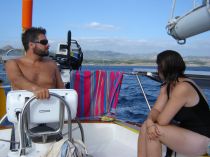 Sean and Sara say goodbye to Las Frailes
Sean and Sara say goodbye to Las Frailes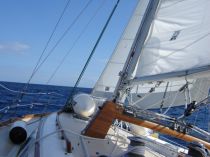 We tightened the mainsail halyard right after this photo
We tightened the mainsail halyard right after this photo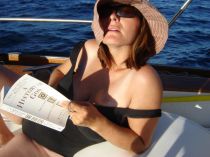 Sara working on her tan lines
Sara working on her tan lines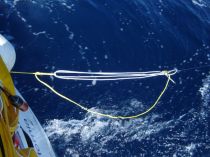 Here fishy fishy fishy!
Here fishy fishy fishy!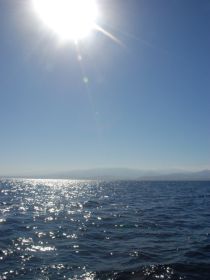 Beautiful day on the ocean
Beautiful day on the ocean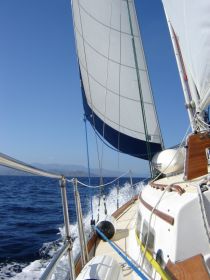 Splashing through the waves
Splashing through the waves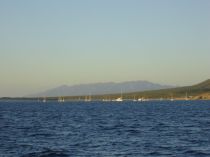 Arriving in Ensenada de los Muertos
Arriving in Ensenada de los Muertos Will brings us into the anchorage
Will brings us into the anchorage The Giggling Marlin - the restaurant in the middle of nowhere
The Giggling Marlin - the restaurant in the middle of nowhere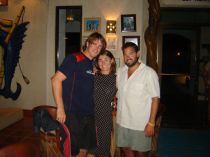 Dinner and drinks in the middle of nowhere
Dinner and drinks in the middle of nowhere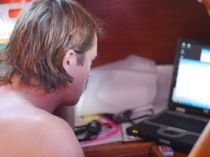 Will checking the classifieds for dinghies
Will checking the classifieds for dinghies Purpeat pulled waaaay up on the beach
Purpeat pulled waaaay up on the beach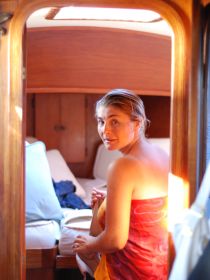 Sara getting ready for the party
Sara getting ready for the party Happy couple on the beach
Happy couple on the beach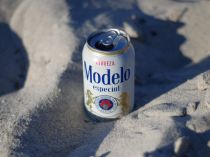 Beach party!
Beach party!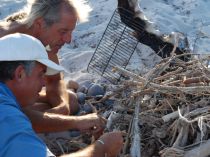 Getting the fire ready
Getting the fire ready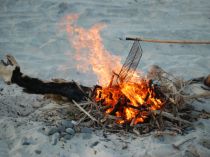 Burn baby burn
Burn baby burn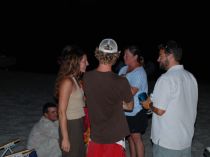 Chillin with our amigos
Chillin with our amigos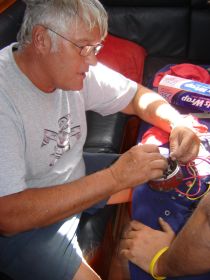 Richard disassembling the windlass motor
Richard disassembling the windlass motor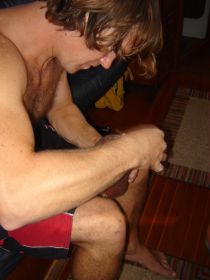 Will re-assembling our first attempt
Will re-assembling our first attempt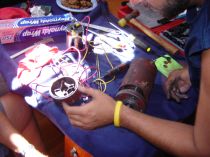 Uh, where does this shiny thing go?
Uh, where does this shiny thing go? Chewing gum and paperclip repair service
Chewing gum and paperclip repair service Road trip! Did you pack the anchor?
Road trip! Did you pack the anchor? Nice placement
Nice placement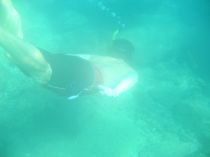 Will swimming with the fishes
Will swimming with the fishes The cow of the sea
The cow of the sea